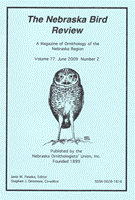Nebraska Ornithologists' Union

Nebraska Bird Review
Date of this Version
6-2020
Document Type
Article
Citation
The Nebraska Bird Review, Volume 88 June 2020 Number 2, pp. 75-90.
Abstract
On May 25, 1915, in Lincoln, Lancaster County, Nebraska, a Gray-cheeked Thrush was “killed by flying against the library building on city campus” and was found by Robert H. Wolcott and prepared as a scientific study skin by Leroy M. Gates. This thrush is now ZM-6674 in the University of Nebraska State Museum (UNSM) Zoology collections. Birds are typically killed at low level buildings by flying into windows. This thrush is the first documented window strike death for what is now the University of Nebraska – Lincoln city campus. Based upon the UNSM bird collections I report on the last 100+ years (1915 through Dec 2019) of window strike bird mortalities on the city campus (especially 1985-2019). There were a total of 980 specimens of 87 species from 39 separate buildings or building complexes.
The University of Nebraska State Museum (UNSM) Division of Zoology collections database was examined for avian specimens salvaged from city campus and whose label data indicated they had died, or very likely died, as a result of striking a window. For the purposes of this project the city campus was defined as being bounded on the east by Antelope Valley Parkway, the south by ‘Q’ Street, the west by 10th Street and what is now Interstate 180, and on the north by what is now Salt Creek Roadway and the approximate location of ‘X’ Street. Only specimens salvaged from university-related buildings within those boundaries were included. The campus has changed markedly over the past 100 years. In 1915 it was only beginning to expand beyond the original four city blocks from 10th to 12th Streets and ‘R’ to ‘T’ Streets. Some specimens had a street address recorded and when that could be determined to be a university building, it was included. Building, or building complexes, are recorded in the Appendix using the current name of the building. If questions arose from the database concerning the specimen, the specimen’s original label was consulted.
Included in
Ornithology Commons, Population Biology Commons, Poultry or Avian Science Commons, Zoology Commons


Comments
Published by the Nebraska Ornithologists’ Union, Inc.